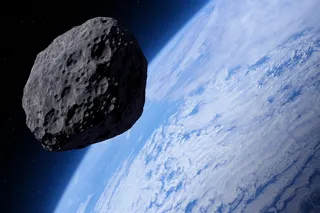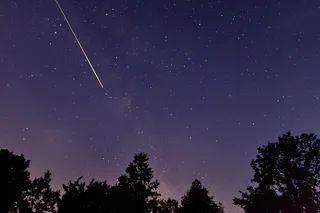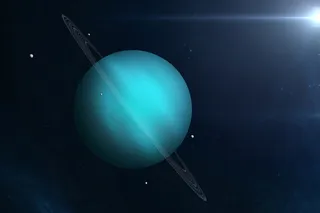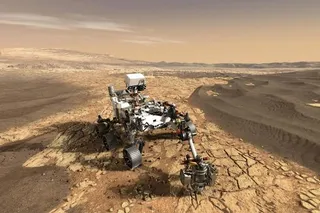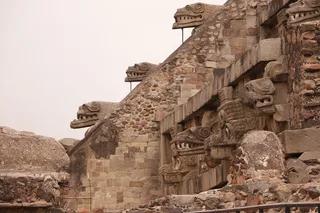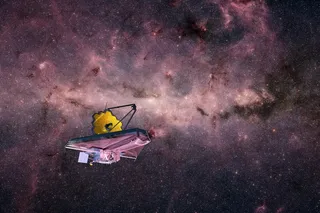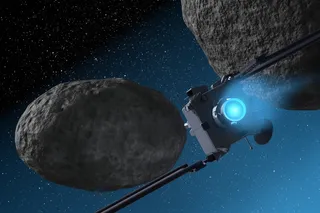In the bedroom of his house in a canyon above Santa Monica, Harold Rosen switches on the high-definition television set. The face of Tom Hanks, who happens to live a few blocks away, fills the five-foot-wide screen, bounced straight from an orbiting satellite to Rosen’s dish antenna poised outside among the hummingbirds and flowers. “I get hundreds of channels for under a dollar a channel,” Rosen says with a grin.
So do millions of others, and they have Rosen to thank for making that possible—and a lot more. It’s easy to forget how miraculous satellite-relayed television would have seemed just a few decades ago. Rosen recalls watching the Tokyo Olympics, the first continuous broadcast by geostationary satellite, relayed live in black and white in 1964. “I was amazed at how good the picture was,” he says. Today when he clicks his remote, channel after channel from around the world appears on the screen: news, talk, politics, science, nature films, and sports.
Rosen, 77, remembers well, because he led the team that invented the first geostationary communications satellite.

Photograph by Amanda Friedman
If Harold Rosen’s team hadn’t figured out how to send satellites to circle Earth in controlled, equatorial orbits, today we’d have no live transmission of the Olympic Games, no satellite phones in Iraq, no faxing to Hong Kong.
The idea for a space-based communications satellite network was first suggested in 1945 by writer Arthur C. Clarke. Many scientists had dismissed Clarke’s proposal as far-fetched. But when the Soviet Union launched Sputnik in 1957, the world looked up and saw that the future of communications hung in space. Rosen and a handful of others would put it there by hurling voice, television, facsimile, and data communication around the world.
Rosen was working at Hughes Aircraft, developing radar systems, when Sputnik went up. Soon he became manager of satellite development. Global communications were still primitive. In 1960 a maximum of 136 Americans could talk to Europe at one time-100 on high-frequency radios and 36 via AT&T’s year-old transatlantic submarine cable. Transatlantic TV didn’t exist. Rosen saw an opening.
Not many did, because the obstacles were enormous. At AT&T’s Bell Laboratories, John Pierce—a scientist “so important he named the transistor the transistor,” Rosen says respectfully—had proposed a fleet of low-altitude communications satellites. In 1960 Pierce persuaded NASA to fund the Echo balloon satellite. Radio waves were transmitted from one ground station to another by bouncing off the aluminum-faced 100-foot-diameter Mylar balloon.
But without amplification, the signals weakened over distance. Telstar 1, a more sophisticated device that amplified and re-sent signals, followed two years later. But the low-flying Telstar didn’t stay in one place, so it could be used only for short periods at a time, and gigantic swiveling ground antennas required complicated electronics to keep them pointed toward the satellite as it passed overhead. The complexity and expense made it difficult for competitors to challenge Bell, then the only telephone company in the United States. Bell, Rosen says, was happy with its monopoly, which the company assumed it would be able to count on as communications became international. However, “a geostationary satellite is much more democratic,” Rosen says, because it’s simpler and cheaper.
His team set out to position a satellite high in space and get it circling Earth’s equator at precisely the right speed to stay above a particular point on the ground, thus making it geostationary. Radio waves bounced to and from that satellite, orbiting at 22,238 miles above Earth, could reach nearly a third of the globe. Rosen thought he could design a small satellite with sufficient bandwidth for television transmission or 100 telephone channels and build it in a year for $5 million. He consulted with fellow engineers Tom Hudspeth, John Mendel, and Donald Williams, and they agreed. Rosen thought it would be very profitable. “Being bold, I said we could probably sell an hour a day of television,” he laughs. “The head of the communications division thought an hour a week would be a lot.” He waves at Tom Hanks on the TV screen.
Booster rockets in those days were still relatively weak, so Rosen’s satellite had to be lightweight. It had to be able to move itself out of the elliptical launch orbit and establish a circular orbit above the equator. There, it would have to remain stable, stay on station, resist the forces of gravity exerted by Earth, the sun, and the moon, and continue facing its ground antenna—all while traveling at a precise 6,878 miles per hour to remain in sync with Earth’s rotation.
Rosen’s plan was to design lighter-weight communications gear and to stabilize the satellite with spin, like a thrown football. The technique had been used to stabilize early booster rockets but to employ it on a satellite still required a leap of faith. A spinning satellite could aim no more than a third of its solar cells toward the sun at one time, and the omnidirectional antennas would broadcast signals indiscriminately in all directions, wasting a lot of the power the satellite collected.
So the team devised an antenna that broadcast a wide, flattened signal rather than a spherical, omnidirectional one, to better focus radio waves. And because transistors didn’t exist that could amplify a signal to cover such vast distances at the necessary frequencies, the team employed a type of vacuum tube called a traveling wave tube, which used high-voltage electrons to increase the power of electronic signal waves. Pierce had worked on the tube, but now Mendel designed a lighter, more efficient version.
Once the electronics were sorted out, the satellite still had to be shot into an elliptical orbit and then somehow moved precisely into a circular path around the equator. Then it had to be stopped, turned to orient its antenna toward Earth, set to spinning again, and kept there. To steer the satellite, Don Williams designed an ingenious two-thruster pulse rocket system, controlled from the ground, that would move it around in space with spurts of compressed nitrogen at just the right points in the satellite’s spin cycle—Rosen’s idea.
Rosen had imagined a 20-pound, 17-inch cube. He ended up with a 25-pound cylinder, 30 inches in diameter and 15 inches tall. Meanwhile, Hughes often withheld funds and support. Pierce thought the concept was impractical. Years later, Rosen says, Pierce apologized. By the time John Rubel, the Defense Department’s research and development chief, visited in the spring of 1961, Rosen had the satellite’s control mechanism working and had transmitted television signals in the lab using its communications equipment. Rubel liked what he saw.
That same spring Rosen’s team built a ground model of the satellite and took it to the Paris Air Show. Setting it up in a booth at Le Bourget Airport, they took video shots of passersby, relayed them 10 feet via microwave to a satellite on a stand, then to a receiver that demodulated the signal and displayed the image on a screen. “It was a real prototype satellite, except for the distance,” Rosen says. In August NASA gave Hughes a contract to build the satellite.
Syncom 1 exploded on launch in February 1963, but that July Syncom 2 was successfully launched into what Rosen describes as a geosynchronous orbit: It circled Earth at a consistent height and longitude, but not precisely above the equator. President Kennedy, in the White House, used it to speak with Sir Abubakar Tafawa Balewa, the Nigerian prime minister, in Lagos-the first live two-way, head-of-state telephone call via satellite relay. Then came Syncom 3. With its greater bandwidth, it could broadcast television. The next year, Rosen told the New York Journal-American that geostationary satellites could result in a million-channel communications network that would relay TV, voice, photo facsimile, and teletype all over the world. Today a Harvard Web site lists hundreds of satellites—Early Bird, Intelsat, Agena, Raduga, Superbird, Gorizont—used for the applications Rosen predicted, as well as for remote sensing for scientific, meteorological, and military purposes.
As a boy in New Orleans, Rosen loved to curl up with one of his dentist father’s physics books: “I loved the mathematics.” He still does. He wasn’t sure he would accept the Discover Award, he says with a smile, because it’s given for lifetime achievement and he’s not finished achieving. He retired from Hughes in 1993 but consults with Boeing Satellite Systems, the firm’s successor, and has also launched his own firm, Volacom.
His new passion is creating another high-altitude communications platform—one that could circle the sky above a city, for example, and provide cheap broadband Internet access, telephone, and local television. He thought about dirigibles, balloons, manned aircraft. “Nothing seemed practical, but then we thought: What about unmanned airplanes?” Working with his engineering partner, J. B. Straubel, and airplane designer Burt Rutan, Rosen developed an unmanned plane powered by a hydrogen engine. It would fly 11 1/2 miles up in a city-size circle, covering less ground than a satellite but having “thousands of times the communication density,” says Rosen. “It’s still a dream. We don’t have FAA or FCC authority to proceed. But as soon as the first high-altitude plane flies, applications will flood in. I think we’ll fly the plane in two years.” Rosen glances at the television. “I like to watch movies,” he says. Then he presses the remote and Tom Hanks disappears—Rosen’s really too busy to watch anything.




